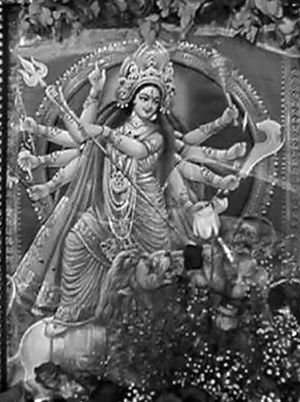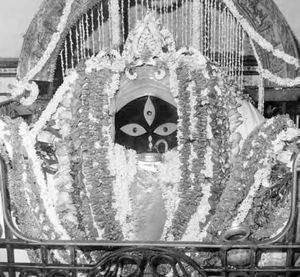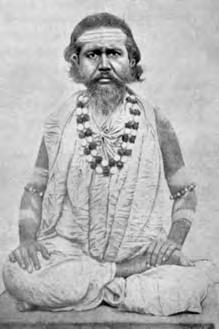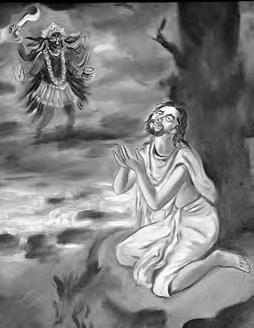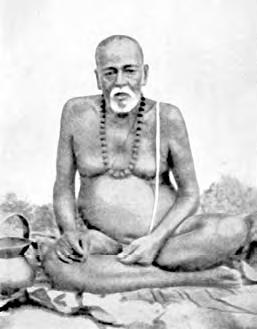Śākta
By Swami Vimalatmananda
Shakti is Power, Energy—the active principle of the universe which is personified as a goddess. Every form of activity—however it be named—proceeds from the primordial Shakti. Shakti pervades the entire universe. It is worshiped as Devi, or the Divine Mother. This worship is popularly known as Shakti Puja; people have been performing Shakti Puja from time immemorial.
It can be seen through the different phenomena of life itself. Durgā Sapta Śati says, ‘yā devī sarvabhūtesu śakti rūpena samsthitā’, meaning "every one of us has the inherent power called Śakti, which is a part and manifestation of Parā Śakti, the Supreme Goddess." The powers of gods came to be known and worshiped by different names and epithets—the Vaisnavī Śaktis like Laksmī, Śrī, Prthivī etcetra, and Śaiva Śaktis like Durgā, Pārvatī, Kālī, and so on. The trinity of Brahmā, Visnu and Śiva work through their Śaktis for the creation, maintenance and annihilation of the world.[1]
The Divine Mother commands as much respect and worship as the other gods and incarnations. There are numerous shrines across the country dedicated to the various forms of the Divine Mother. Feasts and festivities in her honor are an important component of the calendar.
Śāktism and the Śākta[edit]
The worshipers of Shakti are called Śāktas. The Śāktas have their own beliefs, doctrines, tradition, symbols, cult, myths and rituals. These constitute Saktism, the tradition of the Śāktas. According to this tradition, the highest reality is the Divine Mother, the personification of primordial energy, the controller of all forces, the power behind divine and cosmic evolution, and the source of all that exists. Śāktism is based on Vedic mantras and Upanishadic philosophy. It has been propagated by Advaita Vedantins, including prominent ones like Shankara Acharya. According to this tradition, Shakti is identical with Brahman. Shakti and śaktimān (the locus of shakti) are one.
The Puranas mention the prevalence of Śāktism during various historical periods, beginning with Vedic times. But it gained prominence in the epic period.
The origin of Śāktism was spontaneous. It is said to have evolved out of the pre-historic Mother Goddess concept, symbolizing the facts of primitive life. But its development was manifold—not through any one particular channel, but several—like a lot of streams, some big some small, issuing from a single source. The tribal cults of the female deities were woven in the texture of the intellectual and rational scheme of the doctrine upheld by the higher religions.[2]
Śākta literature was written by many great saints, sadhakas, and scholars in different languages in Bengal, Assam, Kashmir, the sub-Himalayan region, and South India. Much of this literature is in Sanskrit, and gives a vivid description of the Śākta religion. It is commonly held that Śāktism is synonymous with Tantra. Tantric ideas profoundly influenced different sects and radically changed their views as well as their practices. But some scholars hold the opinion that Śāktism and Tantra are two separate entities. The term Śākta has a wider import than the appellation Tantric. Also, Śākta literature may be traced back to the Vedas, whereas Tantric literature has a different origin.[3] Dr Winternitz says, ‘When we speak of Tantra, we think primarily of the sacred books of the Śāktas.’[4] Sri Ramakrishna explains the issue thus: ‘The Śāktas follow the Tantra, and the Vaishnavas the Purāna. There is no harm for the Vaishnavas in speaking publicly of their spiritual practices. But the Śāktas maintain secrecy about theirs. For this reason, it is difficult to understand a Śākta.’[5]
The Śākta Philosophy[edit]
Śākta teachings were originally passed on from teacher to student, or guru to śisya, in an esoteric manner; as a result, these teachings remained uncodified for long. Over the last several centuries, many Śākta sadhakas and scholars have contributed to the progress of the Śākta philosophy. The ‘knowledge portion’ of Tripura-rahasya throws much light on the Śākta philosophy. The Sri-vidya-ratna-sutra, attributed to Acharya Gaudapada, is also a useful Śākta text. Abhinavagupta’s works established Śākta philosophy on a firm foundation. Punyananda’s Kamakala-vilasa is an authoritative work on Śākta philosophy. The best exposition of Śākta philosophy is probably Bhaskararaya’s Setubandha, dated to the eighteenth century. Sir John Woodrofe and his associates elaborately expounded the Śākta philosophy during the first three decades of twentieth century. In 1937, Panchanan Tarkaratna expounded the Brahma Sutra and Isha Upanishad from the Śākta viewpoint. This attempt was furthered by Mahamahopadhyaya Gopinath Kaviraj. Though originally based on Sāmkhya philosophy, Śākta philosophy has been deeply influenced by the non-dualistic school of Vedanta. It however shares its terminology with the other schools of philosophy.
In Śākta philosophy, the ultimate reality is pure Consciousness, known as Samvit. It is an independent entity, and its power is responsible for all activity. It has both static and dynamic aspects: prakāśa and vimarśa. It is both immanent and transcendent. Samvit remains as pure cit-śakti (consciousness power)—also termed Parā-Prakrti—at the time of dissolution of the universe. Shakti manifests itself as avidyā or material prakrti when material entities evolve.
The evolution of the material world from pure Consciousness has been conceived as taking place in three stages—the seed stage, the mixed stage and the final stage.
- In the seed stage, matter has not yet appeared as different from consciousness.
- The mixed stage manifests subtle differences between consciousness and matter.
- The final stage is the gross world as we see it.
This evolution involves four categories—Parameshvara, Shakti, Para-nāda, and Parā-bindu. Parameshvara is the Supreme Being with whom Shakti is in inseparable relation. The appearance of Shakti causes an unmanifested sound called Para-nāda which concentrates itself to a point called Parā-bindu. This Parā-bindu evolves into three parts—Aparā-bindu, Bīja, and Aparanāda. The Shiva element dominates in the Aparābindu and the Shakti element in the Bīja. In Aparanāda, Shiva-Shakti are in equilibrium. The sound caused by the division of Parā-bindu is called Śabda Brahman. The inseparable Shakti of the Supreme Being in the modes of icchā (will) and kriyā (functioning) is responsible for these transformations.
Shakti first manifests as icchā, the desire to create. Subsequently, it works through its two aspects: vidyā-śakti and avidyā-śakti or māyā-śakti. Both of these are conscious principles—the former is illuminating consciousness, the latter, veiled consciousness. Māyā-śakti is composed of the three gunas -- sattva, rajas, and tamas. It is therefore known as trigunā-śakti or kāmakalā, and is symbolized by a triangle. The māyā-śakti is the cause of the material world. Maya is not an unconscious principle; it is consciousness veiling itself as the shakti of the Supreme Being. Sri Ramakrishna has explained this with analogy: ‘He whom you address as Brahma[n] is none other than She whom I call Śakti, the Primal Energy’ [6]. ‘Thus Brahman and Śakti are identical. If you accept the one, you must accept the other. It is like fire and its power to burn. If you see the fire, you must recognize its power to burn also. You cannot think of fire without its power to burn, nor can you think of the power to burn without fire. You cannot conceive of the sun’s rays without the sun, nor can you conceive of the sun without its rays’ [7].
Shivachandra Vidyarnava, Gopinath Kaviraj, and John Woodrofe have extensively interpreted the Śākta Philosophy. Narendra Nath Bhattacharya has summed them up succinctly:
The Supreme Being of Shaktism is not a personal God. In its own nature, it is more than that. The Shakta point of view considers the reality of God as the cause of the universe. But it holds that while the effect as effect is the cause modified, the cause as cause remains what it was, what it is, and what it will be. It holds that the Supreme Being is manifested in one of its aspects in an infinity of relations, and though involving all relations within itself, is neither their sum total nor exhausted by them. Shakti, which is its functional aspect, works by negation, contraction, and finitisation. As a Mother Power, she upholds herself into the world and again withdraws the world into herself. The purpose of her worship is to attain unity with her forms and this is the experience of liberation—a state of great bliss (anandaghana). In the natural order of development, Shakti is developed in worldly things but it is controlled by religious sadhana, which both prevents an excess of worldliness and molds the mind and disposition (bhava) into a form which develops the knowledge of dispassion and non-attachment. Sadhana is a means whereby bondage becomes liberation.[8]
Śākta Sadhana[edit]
The philosophy of the Śākta-s is designed to be an aid for practitioners in order to help them reach realization. This practice is called sadhana. This is Śākta contemplation, the practical aspect of the Śākta tradition. Contemplation is achieved through spiritual discipline. Only then is spiritual liberation possible, and will the sadhaka enjoy eternal peace. This is called śākta sādhanā. This sadhana has some distinctive features, although truly speaking, all sadhanas are essentially Śākta sadhana. This sadhana is open to all men and women according to their competence and constitution. It has many stages and categories. The sadhaka is to choose his or her own path with the aid of a guru.
The Śāktas give much importance to the physical constitution. According to them, realization is difficult if the sadhaka does not have a suitable physique. The body is full of various energies; the aim of sadhana is to master and manifest these energies.
Śākta sadhana is actually the practice of Advaita, for it is also the path of jnana. It first involves indirect or scriptural knowledge, śāstra jñāna. Direct perception follows. Though this sadhana involves knowledge, bhakti and karma are given equal importance. Generally speaking, in this sadhana, jnana, bhakti, and karma have been harmonized.
Ācāra and bhāva are the basis of Shakti sadhana. In the Mahanirvana Tantra, Shiva says: ‘Devi, I have told of many ācāras and bhāvas in accordance with the capacity of the adhikarī (aspirant). Among these, some are secret; I have narrated these too (in some other Tantras). Persons competent in (esoteric as well as exoteric) sadhana will get results and cross the ocean of samsara if they follow this path.’[9]
Śākta teachers classify human disposition under three heads—paśu bhāva, vīra bhāva, and divya bhāva. The person with paśu bhāva, or animal disposition, is slave to six enemies: lust, anger, greed, pride, delusion, and envy. An aspirant with vīra bhāva, or fearless disposition, is pure in motive, gentle in speech, and mindful of the pañca tattvas. Such a person is physically strong, courageous, intelligent and enterprising. The character of the person with divya bhāva borders on the divine as a result of sadhana practiced in previous births.
Sri Ramakrishna tells a charming story about śava sādhanā, the prototypical vīra bhāva worship, and about sadhana done in previous births: One must admit the existence of tendencies inherited from previous births. There is a story about a man who practiced the śava sādhanā. He worshiped the Divine Mother in a deep forest. First he saw many terrible visions. Finally a tiger attacked and killed him. Another man, happening to pass by, and seeing the approach of the tiger, had climbed a tree. Afterwords, he got down and found all the arrangements for worship at hand. He performed some purifying ceremonies and seated himself on the corpse. No sooner had he done a little japa than the Divine Mother appeared before him and said: ‘My child, I am very much pleased with you. Accept a boon from Me.’ He bowed low at the Lotus Feet of the Goddess and said: ‘May I ask You one question, Mother? I am speechless with amazement at Your action. The other man worked so hard to get the ingredients for Your worship and tried to propitiate You for such a long time, but You didn’t condescend to shower him Your favor. And I, who don’t know anything of worship, who have done nothing, who has neither devotion nor knowledge nor love, and who haven’t practiced any austerities, am receiving so much of Your grace.’ The Divine Mother said with a laugh: ‘My child, you don’t remember your previous births. For many births, you tried to propitiate Me through austerities. As a result of those austerities, all these things have come to hand and you have been blessed with My vision. Now ask Me your boon.’[10]
There are seven ācāras or rules of conduct, which are related to the spiritual states of the sadhaka—vedācāra, vaisnavācāra, śaivācāra, daksinācāra, vāmācāra, siddhāntācāra, and kaulācāra. These ācāras are closely connected with bhāvas. [11]
The aspirant rises step by step through these different ācāras till he reaches the seventh and highest stage, when Brahman becomes an experiential reality to him. In the first stage, cleanliness of the body and mind is cultivated. The second stage is that of devotion (bhakti). The third is that of jñāna (knowledge). Daksina, which is the fourth stage, is that in which the gains acquired in the preceding three stages are consolidated. This is followed by vāma, which is the stage of renunciation. This does not mean, as has been said by the detractors of the Tantra, the practice of rites with a woman (vāmā). Vāma is the reverse of daksina; which means the path of renunciation. If a woman is at all associated in this practice, she is there to help in the path of renunciation, and not for gratification of animal desires. A woman as such is an object of great veneration to all schools of Tāntrika sādhakas (seekers). She is considered to be the embodiment on earth of the supreme Śakti who pervades the universe. She should therefore be revered as such and, even if guilty of a hundred wrongs, she is not to be hurt even with a flower. It is a sin to speak disparagingly of any woman. The sixth stage, viz. siddhānta, is that in which the aspirant comes to the definitive conclusion after deliberate consideration as to the relative merits of the path of enjoyment and that of renunciation. By pursuing the latter path, he reaches the final stage of kaula. This is the stage in which Kula or Brahman becomes a reality to him. The first three of these seven stages, viz., veda, vaisnava, and śaiva, belong to paśubhāva; daksina and vāma belong to vīrabhāva; and the last two belong to divyabhāva. According to some, the last alone is divyabhāva. The Paraśurāma Kalpa-Sūtra says that during the first five stages, the aspirant must be guided by the teacher and it is only afer he has passed the fifth stage that he is allowed to have freedom of action in every way.[12]
| ||||||
The Śāktas have a set of well-defined rules for worship of the Divine Mother in her various forms—Kali, Durga, Jagaddhatri, and the like. The object of this worship is realization of the supreme Consciousness. This is done through the use of mantras and yantras, and the practices of nyāsa, bhūta-śuddhi, pranayama, dhyana, prāna-pratisthā, mānasa- and bāhya pūja. At present, this method forms the basis of worship of all deities. The worshiper seeks to rouse the power of the kundalini (ādhāraśakti, the basal power), which is located in the mulādhāra, the lowest of the six chakras in the body. Then the worshiper, the worshiped, and the means and acts of worship will be transformed into caitanya—Consciousness. The passage of the awakened kundalini through successively higher chakras — svādhisthāna, manipura, anāhata, viśuddha,and ājnā, are accompanied by a progressive transformation of consciousness (and deepening spiritual insight). Its penetration of the sahasrāra leads to the ultimate transcendental experience of Consciousness and results in eternal bliss.
Sri Ramakrishna’s experiences closely match the descriptions found in the shastra-s. For instance,he says, ‘I had, in the beginning, the vision of particles of light like groups of fire-flies; I saw sometimes all quarters covered with masses of mist-like light; and at other times I perceived that all things were pervaded by bright waves of light like molten silver.’[13] This is comparable to the description available in Shvetashvatara Upanishad[14].
The pañca tattva-s, or five principles, are an integral part of tantric rites. These are commonly referred to as the five ‘M’s, pañca-makāra—madya, wine; māmsa,meat; matsya, fish; mudrā, cereals, and maithūna, sexual union. However, this is only one interpretation. Sri Ramakrishna practiced Tantrasadhana according to the rules of sixty-four different categories of Tantra under the guidance of the Bhairavi Brahmani. He passed through the entire course without deviating from his ideal of ‘motherhood in all women’ and without taking even a sip of wine. Swami Nirvedananda has recorded the unique significance of Sri Ramakrishna’s Tantric sadhana in ‘Sri Ramakrishna and Spiritual Renaissance’:
During this period, he had quite a multitude of wonderful visions that followed one another in quick succession. Of all the divine forms he witnessed, Sodaśī or Rājarājeśvarī appeared to him to be the loveliest. Moreover, he perceived the upward march of the kundalinī-śakti, described in the Yoga and Tāntrika scriptures as the coiled-up divine energy lying normally in every man at the lower end of the spinal canal. When it is made to rise farther up by spiritual practice, its progress through the different stages is marked by distinct phases of spiritual experience on the part of the devotee, culminating in convergence in the Absolute. Ramakrishna verified the scriptural statements by experiencing all the various spiritual moods and visions corresponding to the different stages of ascent of the coiled-up divine energy. His unique success in Tāntrika practices, without any connection with wine or sex, has undoubtedly restored the purity of these ancient practices and stamped them afresh as a sure and distinct approach to the realization of God.[15]
They Lived with the Divine Mother[edit]
The practice of Śāktism is open to all, to renunciants and householders alike. If one practices the disciplines laid down in the Śākta shastras, one is entitled to the highest spiritual attainments. There are innumerable examples of sadhakas who, by practicing Śākta sadhana as per the Śākta shastras, have realized the supreme Consciousness and its manifestation as Shakti. Besides Sri Ramakrishna, some of the other Śakta sadhakas of repute who achieved supreme knowledge by practicing Śāktasadhana are Krishnananda Agamavagisha, Raja Ramakrishna, Swami Sarvananda, Kamalakanta, Ramprasad, Bamakshyapa, Brahmananda Giri, Puranananda Paramahamsa Parivrajaka, and Shivachandra Vidyarnava of Bengal; Nilkantha of Maharashtra; Adyananda of Nepal; Srinivas Bhatta Gosvami of South India; Shivananda Nath of Varanasi; Abhinavagupta and Sahib Kaula of Kashmir; and Gangesha Upadhyaya of Mithila. Their lives and methods of sadhana are inspiring. They practiced sadhana according to Śākta rules and were blessed with the vision of the Divine Mother. Some of them jotted down their experiences; their writings have in course of time become authentic reference works for this tradition. Some of them are poet saints whose compositions are still inspiring people and elevating the minds of sadhakas to higher states of devotion. Kamalakanta, Ramprasad, and Chandidas of Bengal belong to this group of sadhakas. Sarvananda of Tripura was totally illiterate; his spiritual success came through repetition of the mantra alone. He practiced the very difficult śava sādhanā. He earned the epithet of sarvavidyā, as all known forms of the Divine Mother were revealed to him. Ratnagarbha or Gosain Bhattacharya of sixteenth-century Bengal followed the vīra form of worship using pañca makāra and attained siddhi, perfection. Ardhakali of Mymensingh was born a daughter of Dvijadeva Thakur about three hundred years ago. It is believed that she was an incarnation of the Divine Mother. She was married to Raghavarama, a soul highly advanced in yoga, and at the time of marriage, she revealed her divinity. Bamakshyapa (mad Vama) was born about three hundred years ago in a village of Birbhum. He was a devotee of Goddess Tara, but seldom offered any formal worship. He practiced only meditation on Tara and had the vision of the Divine Mother.
Chintacharan Chakravarty has rightly observed that ‘the ennobling spirit of devotion and the high tone of spirituality imparted by Śāktism have attracted and are still attracting a very large number of people not only in Bengal, but all over India’. [16]
Conclusion[edit]
Traditional Śākta sadhana is not practiced much today, but the worship of the Divine Mother still plays a vital role in this tradition. This worship allows for the integration of aspects of human life into a whole, which includes the achievement of a type of balance in view of the oft-stated generalization that religious pantheon structures tend to mirror the socio-political structures of civilizations’.[17] Even from the purely human point of view, this tradition of worship has proved to be remarkably elevating. As W C Beane puts it: ‘Individuals might therefore learn from the testimony of the worshipers of the goddess that, even if certain ideas and forms of the Tantric vogue may be found unsuitable to certain modern milieu, it is essentially the vision of what both man and woman can become to one another in mutual respect of one another’s identity, influence, and activity in the world that matters finally.’[18]
References[edit]
- ↑ Pushpendu Kumar, The Principle of Śakti (Delhi:Eastern Book Linkers, 1986), I.
- ↑ Narendra Nath Bhattacharya, History of Śākta Religion (Delhi: Munshiram Manoharlal, 1996),xi–xii.
- ↑ Govinda Gopal Mukherjee, ‘Śākta Literature’, in Languages and Literatures, ed. Suniti Kumar Chatterjee,vol. 5 of The Cultural Heritage of India (Calcutta: Ramakrishna Mission Institute of Culture,1978), 130.
- ↑ Atal Behari Ghosh, ‘The Spirit and Culture of the Tantras’, in The Religions, ed. Haridas Bhattacharyya,vol. 4 of The Cultural Heritage of India, (Calcutta:Ramakrishna Mission Institute of Culture,1956), 241.
- ↑ The Gospel of Sri Ramakrishna, trans. Swami Nikhilananda (Chennai: Ramakrishna Math, 2002), 538.
- ↑ The Gospel of Sri Ramakrishna, trans. Swami Nikhilananda (Chennai: Ramakrishna Math, 2002), 434
- ↑ The Gospel of Sri Ramakrishna, trans. Swami Nikhilananda (Chennai: Ramakrishna Math, 2002), 134
- ↑ Bhattacharya, Narendra Nath, History of Śākta Religion, 215–16.
- ↑ Mahanirvana Tantra, 4.36–7.
- ↑ The Gospel of Sri Ramakrishna, trans. Swami Nikhilananda (Chennai: Ramakrishna Math, 2002), 163–4.
- ↑ Atal Behari Ghosh, ‘The Spirit and Culture of the Tantras’
- ↑ Atal Behari Ghosh, in The Religions, 243.
- ↑ Swami Saradananda, Sri Ramakrishna the Great Master, trans. Swami Jagadananda (Madras: Ramakrishna Math, 1991), 165.
- ↑ 'Shvetashvatara Upanishad, 2.11
- ↑ Swami Nirvedananda, ‘Sri Ramakrishna and Spiritual Renaissance’, in The Religions, 668.
- ↑ Chintaharan Chakravarti, ‘Śakti-worship and the Śākta Saints’, in The Religions, 418.
- ↑ Wendell Charles Beane, Myth, Cult and Symbols in Śākta Hinduism: A Study of the Indian Mother Goddess (New Delhi: Munshiram Manoharlal, 2001),269
- ↑ Wendell Charles Beane, Myth, Cult and Symbols in Śākta Hinduism: A Study of the Indian Mother Goddess (New Delhi: Munshiram Manoharlal, 2001),269
- Originally published as "The Śākta Contemplative Tradition" by Prabhuddha Bharata January 2007 edition
. Reprinted with permission.


